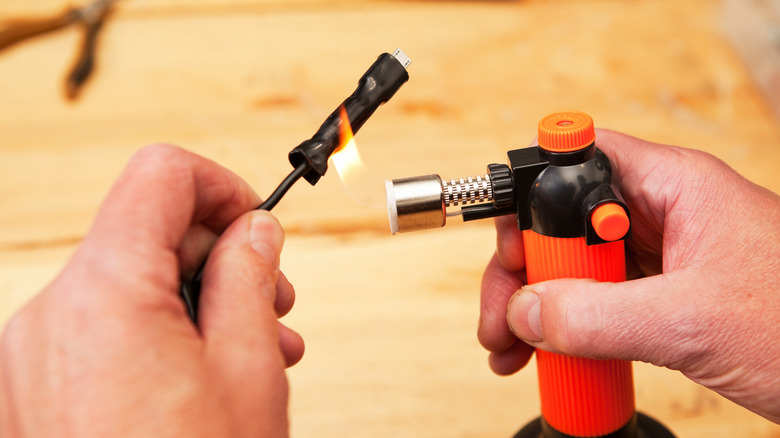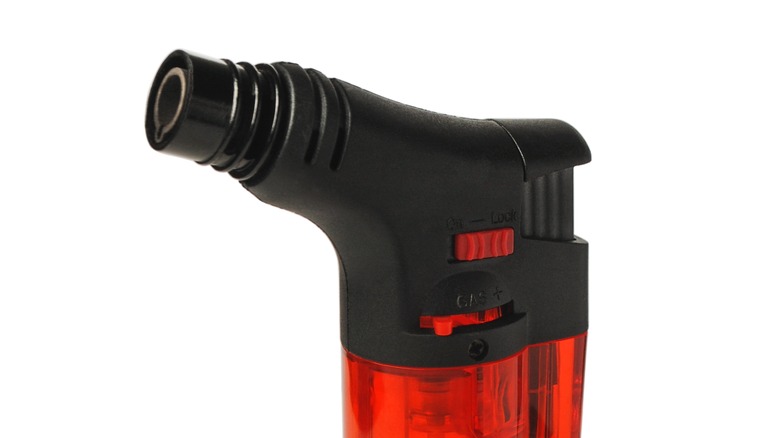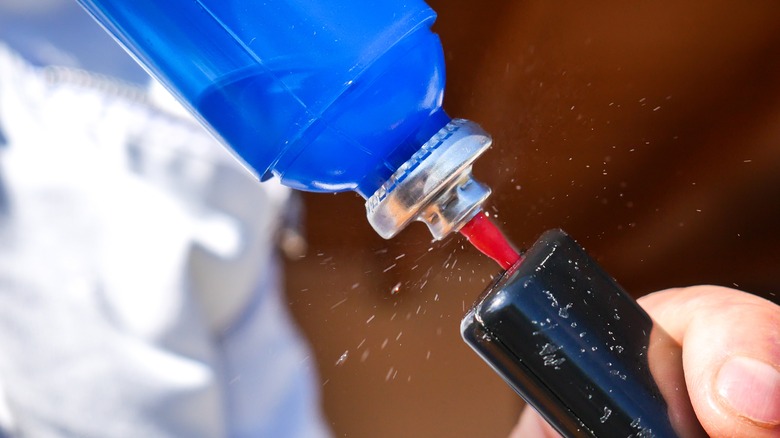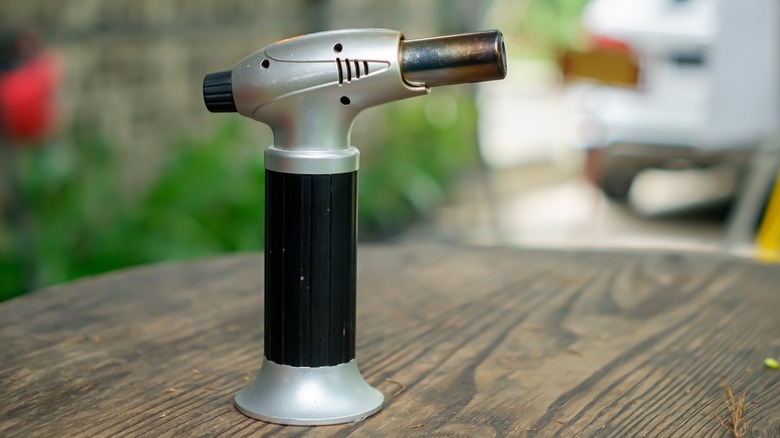We may receive a commission on purchases made from links.

Banksphotos/Getty Images
Butane fuel isn’t just for powering camping stoves. A butane lighter or torch is a handy tool to have in the kitchen, in the workshop, or in a portable welding kit. You can use one to caramelize the sugar on top of a crème brûlée, solder copper plumbing pipes, loosen stuck fasteners, and even mend the metal components of jewelry. Of course, like any other source of powerful heat, a butane torch can’t do its fiery business if it doesn’t have fuel to burn.
Advertisement
A butane torch regularly burns up its internal supply of butane fuel, and when it runs out, you won’t get a flame. Thankfully, if your butane torch is sputtering out, all you have to do is refill the fuel, and you can get right back to controlled burning. Given a torch’s lack of obvious ports, this may seem like a difficult task, but as long as you have the right tools and know where to look for the important bits, it’s actually pretty straightforward.
Take precautions by using the right tools and proper fuel
Before we can refill the fuel, we need to get some tools together, as well as take a few safety precautions. We’re dealing with a fire-producing tool here, so you can never be too safe.
Firstly, if your lighter has only just run out of fuel after prolonged use, don’t try to refill the fuel right away. If it’s still hot, give it about 10 minutes to naturally cool back down to room temperature. You should also ensure that there are no open flames or sources of high heat while you work, as you’ll be handling flammable fuel.
Advertisement
Speaking of which, while you wait for your lighter to cool off, you should get your tools together, the first being a canister of butane fuel. Try to get some premium-grade fuel from a reputable brand like Colibri – using the cheap stuff will clog the lighter.
In addition to the fuel, you’ll also want a small flathead screwdriver, as well as a small, thin plastic pick, like something you’d use to press a small reset button on an appliance. You can get a cheap screwdriver from Harbor Freight for less than five bucks.
Turn the flame height adjuster to its lowest setting

AnTish/Shutterstock
Once your butane torch has cooled down sufficiently, the first step is to turn down the flame height adjuster. This is a small dial present on most butane torches and lighters that controls how far the flame projects when the torch or lighter is active. Depending on the precise model of your torch or lighter, this can take the form of a manual switch on the side of the tool or a small dial on the bottom. In the former case, just flip the switch all the way down to its lowest setting.
Advertisement
In the latter case, you’ll need to use a small tool to adjust the dial. Your lighter may have come with a small key you can use to adjust the dial, but if you don’t have that, that’s what the flathead screwdriver is for. There should be a minus (-) and plus (+) sign indicating the higher and lower settings; turn the dial toward the minus sign until it won’t turn anymore. Doing this will ensure the tool won’t spontaneously spark while you’re refilling the fuel.
Vent out the leftover air
Once the flame adjuster is at its lowest setting, the next step is to ventilate any excess air in the fuel tank. Butane fuel is mixed with compressed air to keep the fuel flowing safely inside the torch, but after the fuel is expended, there may still be some air left in the tank. As long as that air’s in there, you won’t be able to add more fuel.
Advertisement
Check the bottom of the torch or lighter to find a small, round refill valve. Using your plastic poking implement, gently, yet firmly press down on this valve. You should immediately hear a hissing sound as the air starts to escape. Keep that valve held down for about five seconds — you want to vent the air out completely, so keep it going until the hissing either becomes very faint or stops entirely.
As a side note, if you couldn’t find a plastic poking tool, you can use the screwdriver again to press the valve. Be careful, though, as a metal implement could damage the valve if you press it too hard.
Spray in the butane fuel

Mirko Maier/Shutterstock
With the flame strength turned all the way down and the fuel tank completely emptied of air, it’s finally time to add in the butane fuel. During this step, make sure you’re working in a well-ventilated area, such as next to an open window. You should also point the lighter away from your face while you refill, both to prevent inhalation and as a precaution against spontaneous sparks.
Advertisement
Set the torch or lighter upside-down on a solid surface with the refill valve facing up. If it doesn’t have a flat top, you’ll need to hold it steady with one hand, though you should do that either way. Remove the top from the butane fuel canister and give it a quick shake to get it ready. Hold the canister upside-down and gently insert the stem into the refill valve. Press the can into the valve to begin dispensing fuel, holding it for about five seconds. After that initial burst, continue pressing the can to add more fuel in small bursts until the tank is sufficiently filled.
If you see any droplets of fuel flying out or hear a high-pitched hissing sound, the fuel may be leaking out. This is usually caused by not holding the torch or lighter perfectly straight, so take a moment to readjust your grip before you continue.
Advertisement
Let the lighter reset for a moment and readjust the flame height

Benno Putro/Shutterstock
After you’ve finished adding fuel to the torch’s tank, there are still a couple of steps before you can start using it again. First, turn the lighter back over so it’s right-side-up, and let it sit on the table for around five minutes. Butane fuel sprays very cold, so it needs a few minutes to naturally reach room temperature before it can be safely heated.
Advertisement
After that, set the flame height adjuster to your preferred setting. Again, depending on the model, you can do this with either a manual switch or by turning the small dial with a screwdriver. Give the lighter a test lighting to make sure the flame is coming out properly. If you don’t see a flame, you may not have released enough air or added enough fuel. Repeat the steps to vent the air and fill the tank properly.